
Nonprofit Marketing And Communications
Uncover the keys to impactful marketing and compelling communications with our extensive collection of educational videos–tailored to meet the needs of nonprofits. Immerse yourself in learning about effective branding, content strategy, social media engagement, and beyond. Each of these lessons, guided by seasoned nonprofit professionals, will provide you with a deeper understanding of the unique marketing landscape nonprofits navigate, and equip you with practical skills to communicate your mission convincingly. You’ll learn how to amplify your organization’s voice and make it resonate with potential donors, volunteers, and the communities you serve. Dive deep into topics like creating inspiring narratives, building influential marketing campaigns, and leveraging the digital world to reach broader audiences.

How do you win the hearts—and hands—of Gen Z donors? According to Emily Tisdale, West Coast Manager for Team for Cures at the Multiple Myeloma Research Foundation (TheMMRF.org), you stop seeing them as “the future” and start engaging them right now.
In this lively session, Julia C. Patrick explores Gen Z’s philanthropic behavior with Emily, who’s on the frontlines of volunteer and donor engagement across three major markets. Emily doesn’t mince words: “This generation is not transactional. They want to be part of the change.” That means showing up, speaking out, and yes—expecting organizations to be transparent and impact-driven.
Emily explains how COVID-era isolation shaped Gen Z’s digital-first instincts, but also fueled a hunger for purpose. Whether it’s advocacy via Instagram, fundraising through peer networks, or attending real-life charity walks, Gen Zers are ready to get involved—when the mission speaks to them. “They don’t want to just cut a check and sit back,” she adds. “They want action.”
Julia challenges common assumptions about younger donors being flaky or too young to matter. Emily pushes back with stories of college students becoming long-term supporters, and volunteers maturing into major funders. “We need to meet them where they are today,” she says. “Because where they’re going is powerful.”
The conversation covers everything from social media strategies to cross-generational mentorship. One standout idea? Pair Gen Z volunteers with seasoned ones to create a mutual growth loop. “Our high-impact volunteers can become our highest-impact donors,” Emily points out.
Whether you’re building out a peer-to-peer campaign or rethinking how you cultivate loyalty, this episode offers a smart, real-world roadmap for tapping into Gen Z’s energy and values.

Jared Walker, founder of Dollar For, shares how one TikTok video launched a national movement to eliminate medical debt through little-known hospital financial assistance policies. Joined by cohosts Julia Patrick and Sherry Quam Taylor, Jared recounts how a personal family tragedy sparked his commitment to helping others avoid the crushing financial fallout of medical emergencies.
Dollar For educates the public about financial assistance programs that nonprofit hospitals are legally required to offer under the Affordable Care Act. Despite these policies existing for over a decade, most patients—and even medical professionals—remain unaware. “Most people leave the hospital without any knowledge of these programs,” Jared explains. “It’s the best-kept secret in healthcare.”
Jared’s journey from grassroots crowdfunding in Portland coffee shops to leading a national nonprofit began with a single TikTok that received over 30 million views. That exposure helped grow Dollar For from a one-person operation to an 18-person team that’s relieved $88 million in medical debt so far. “We created a Slack channel where every debt relief success story gets posted,” Jared says. “It’s a little mini-party that keeps us grounded in our mission.”
The discussion explains how Dollar For’s first major initiative was building a national database of 8,000 hospital financial policies. This tool lets users instantly check eligibility based on their income and hospital—a game-changing resource in a fragmented system. It also positioned Dollar For as a watchdog, helping policy groups compare hospitals’ generosity and push for improvements.
Despite the impact, Jared remains humble and forward-looking: “I hope Dollar For doesn’t exist in 10 years,” he says. “We’re trying to push for a policy that requires hospitals to screen for eligibility before sending bills.”
The socially impactful discussion also explores the challenges of funding innovation in the nonprofit sector. Jared candidly shares how finding donors who support both direct service and systemic policy change has been a balancing act—but the return on impact is clear. “We’ve turned every donated dollar into over $20 of medical debt relief,” he notes.
Sherry adds, “This is one of those niches where you have the ability to attract investment-level donors who want root, sustainable change.”
This conversation is more than a dive into leadership—it’s a blueprint for innovation, equity, and the power of digital media to mobilize change in a deeply broken system.
00:00:00 Welcome intro
00:01:38 What Dollar For does and why it matters
00:02:56 Legal background on hospital financial assistance
00:04:45 Jared’s personal story and nonprofit founding
00:06:22 Discovering charity care and launching Dollar For
00:09:29 Going viral on TikTok and building awareness
00:11:04 Celebrating impact through team connection
00:14:36 Data, privacy, and insights from patient cases
00:17:19 Expanding partnerships and target demographics
00:20:11 Long-term vision for policy change
00:22:14 How Dollar For is funded
00:24:55 The dual focus on service and policy advocacy
#MedicalDebtRelief #NonprofitInnovation #HospitalPolicyChange
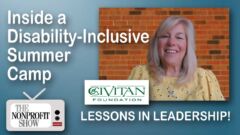
Dawn Trapp, CEO of the Civitan Foundation AZ, delivers an inspiring and detailed look into how her organization successfully runs a summer camp for individuals with disabilities. With operations dating back to 1968, Civitan has evolved from a modest two-week camp into a year-round service hub providing inclusive programming, employment training, arts initiatives, and a deeply supportive community.
Dawn shares the journey of navigating decades of change—from shifting public perceptions to compliance with modern licensing, insurance, and risk management needs. The organization made a pivotal decision during COVID to remain open, extending their camp season when many others shut down. “We stayed open… and it was probably one of the best decisions that we made for everybody,” she says, reflecting on how camp served as a safe haven for campers and staff during uncertain times.
Camp Civitan serves a broad age range—from 5 to 83—and a spectrum of disabilities, tailoring programming to meet diverse needs. Dawn emphasizes the importance of respite not just for the campers, but for their families. Many use state-provided respite funding to cover attendance, enabling caregivers to rest, while campers experience joy, independence, and connection.
Staffing is one of Civitan’s most pressing challenges, especially given its rural location. Dawn shares how they addressed this by bringing in international staff and launching the "Grow Our Own" program, cultivating future leaders from within their own volunteer base—some of whom started at age six and are now on staff. Civitan also maintains ownership of its 15-acre camp, which provides long-term flexibility but comes with substantial cost and maintenance responsibilities.
From risk mitigation to community partnerships, Dawn’s candid discussion reveals the complexity of operating a mission-aligned, community-centered facility. Her closing thoughts on legacy and leadership succession reflect a long-view commitment: ensuring Civitan continues to thrive for generations to come.
#InclusiveCamps #DisabilityServices #NonprofitLeadership
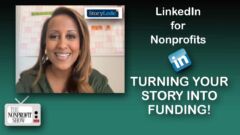
Are you a nonprofit leader hiding in plain sight on LinkedIn? Emmy Award-winning journalist and founder of StoryLede, Bofta Yimam, delivers a powerhouse session on transforming your LinkedIn presence into a strategic tool for visibility, donor attraction, and lasting impact.
In this energized, tactical conversation, Bofta lays out why storytelling and consistency—not just random posts—are the keys to creating real ROI on LinkedIn. Whether you're leading a small startup or managing a national organization, this episode will challenge your thinking and upgrade your online presence.
| “Nonprofit leaders who own their story decide that the vision is more important than their ego.”
| “People care about transformation. They want to know how you got here and why you care so much.” –
Top LinkedIn Success Tips You’ll Learn:
Post 3x a week with intentionality
Define 5 personal or organizational themes to build content around
Use the first 200 characters of every post as a hook
Share transformation stories that connect emotionally
Stop over-selling—focus on thought leadership
Don’t interrupt high-performing posts
Engage meaningfully before and after you post
Add new eyeballs weekly (via search + 2nd connections)
Rotate post types: carousel, tips, video, and inspiration
Support others’ content—remember, it’s social media!
Whether you're seeking more visibility, stronger donor relationships, or a better brand narrative, this episode is a LinkedIn masterclass built for the nonprofit world. Follow the ongoing conversation at #TheNonprofitShow
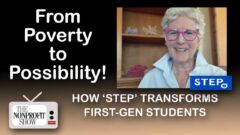
Dr. Tracy Baynes—Founder and CEO of the Student Expedition Program (STEP)—shares how a wilderness leadership initiative evolved into a powerful, multi-year college access program transforming lives.
STEP focuses on first-generation, low-income students in large public high schools, many of whom might otherwise never be encouraged to pursue higher education. Through a personalized approach—monthly workshops, advising, and family engagement—STEP prepares students academically, emotionally, and practically to not just attend college, but to thrive in it.
Dr. Baynes explains how her early career working aboard ships and in outdoor education sparked an uncomfortable realization: “I was only working with wealthy students. And I thought, where is everybody else?” This question became the genesis of STEP.
Over time, the program matured from summer expeditions to a fully integrated college prep curriculum starting in students' sophomore year. The turning point? A high-achieving student inspired by Dr. Baynes to apply to Smith College—without ever having heard of it before. But her transcript lacked the rigor. “She had straight A’s throughout high school and not a single educator had said, ‘You should take another course,’” Dr. Baynes recalls. That gap in guidance pushed STEP to grow.
The conversation unpacks the hidden roadblocks facing low-income students: lack of college counseling, financial aid complexity, and cultural barriers. Dr. Baynes’ solution? Equip both students and families with knowledge, tools, and confidence. “Our goal is to become obsolete in your life,” she says. “We want you to have the tools to meet the challenges ahead.”
Today, 96% of STEP graduates are enrolled in or have completed college. The secret sauce? Relational trust, rigorous expectations, and strategic partnerships with schools that meet 100% of students’ financial need.
If you believe in generational change through education, this episode will challenge, inspire, and empower you to see possibility where others see limitation.
#FirstGenSuccess #CollegeAccessForAll Follow the ongoing conversation at #TheNonprofitShow

Rebranding a nonprofit isn't just about new logos or fresh colors—it's an emotional journey deeply rooted in the mission, culture, and service commitment of an organization. James Dismond, CEO of Mirasol Health, formerly Hospice Care of the Low Country, joined host Julia Patrick to share the inspiring, often emotional, details of their transformative rebranding.
For decades, Hospice Care of the Low Country was a dedicated nonprofit, caring for patients facing end-of-life scenarios. Yet, despite their essential services, the organization faced an existential challenge: staying relevant in an evolving healthcare landscape. A candid internal study revealed a stark truth: if no changes were made, they faced closure within five years.
James vividly recalls the moment that changed his personal and professional trajectory. On his very first day, several patients passed away, confronting him directly with his deepest fear—death. Instead of turning away, he embraced this fear, turning it into a profound passion. James noted, “That fear has since transcended into my greatest passion, and I'm very blessed for that.”
The rebranding initiative was far from simple. It was two years in the making, involving rigorous strategic analysis, extensive stakeholder consultations, and an honest assessment of community perceptions. The word “Hospice” was a significant barrier, fraught with fear and misunderstanding. This realization was a pivotal turning point. James explains, "The powerful messages we are getting back just touch my heart every single day."
Ultimately, the staff themselves coined the new name, “Mirasol,” symbolizing "rare and radiant sunflower," beautifully capturing the legacy and spirit of the organization's enduring symbol—the sunflower. This rebranding was not merely aesthetic; it expanded the scope of services, adding chronic symptom management and soon behavioral health, significantly broadening their community impact.
The process brought substantial internal shifts, compelling deep introspection and alignment from the board, leadership, and staff. It was emotionally challenging but profoundly rewarding, significantly boosting community engagement, donations, and overall business performance.
Today, Mirasol Health stands as a vibrant example of successful nonprofit transformation, rooted in authenticity and courage. “If you do the research, the strategy, and deliver it thoughtfully, the payoff is truly incredible.”
#NonprofitRebrand #CommunityHealth Follow the ongoing conversation at #TheNonprofitShow
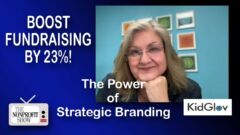
Branding powerhouse Lynn Wineman, President and Chief Strategist at KidGlov.com, explores one of the most misunderstood yet essential components of nonprofit success: branding.
Far from being just a logo or tagline, Lynn reframes branding as a dynamic, multi-layered ecosystem that can dramatically improve a nonprofit’s visibility, trustworthiness, and fundraising effectiveness. Her agency’s proprietary “brand pyramid” lays out the essential building blocks—starting with the organization’s name, followed by the logo, tagline, messaging, visual identity, and finally marketing and advertising execution, which helps leaders see branding as a strategic foundation rather than a cosmetic afterthought.
“Branding is one of very few things that can move the needle on everything you do,” Lynn says, emphasizing that a strong, consistent brand elevates all areas—from donor engagement to volunteer recruitment and even talent acquisition. She points to compelling data from NonProfit Pro showing that organizations with strong, consistent brands can increase their fundraising results by as much as 23%. That lift can be a game-changer!
Yet despite these benefits, many nonprofit leaders are hesitant or ill-equipped to embrace branding. Lynn shares that for most, “just about the time you are sick of something—like, ‘I can't see that logo on my coffee cup one more time’—that's when your audience is just starting to get it.” Her lesson: internal fatigue with brand elements is often a sign of needed consistency, not a call for change.
Lynn also introduces her upcoming book, ‘Untangling Spaghetti,’ which outlines KidGlov’s proven eight-step branding process. It's designed to demystify the process and give leaders a roadmap they can follow with or without agency support.
Throughout the lively discussion, with host Julia Patrick, Lynn talks about those common barriers to branding—including outdated board attitudes, confusion about messaging, and the nonprofit sector’s inclination to prioritize service delivery over strategic communications. But with the right tools and a clear roadmap, Lynn believes any organization can build a brand that reflects its mission, energizes its team, and drives lasting impact!
#NonprofitBranding #MissionDrivenMarketing #SocialImpactStrategy Follow the ongoing conversation at #TheNonprofitShow
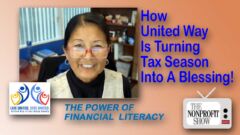
Learn how United Way leverages partnerships to annually reclaim tens of millions in refunds for San Diegans, dramatically impacting lives by providing stability, reducing stress, and fostering community strength.
This lively chat with Nancy Sasaki, CEO of United Way of San Diego County, is about the transformative power of financial literacy. Nancy explains how United Way recognized financial stability as essential for community health. She begins with, “Financial security helps people feel stable and secure, and the pandemic clearly showed how critical this is.”
Discussing their extraordinary collaborative effort through the Earned Income Tax Credit coalition with over 45 organizations, Nancy speaks to the surprising reality for underserved communities: “People who don't make much money often don’t think they'll get taxes back, but they absolutely can.”
This enlightening conversation brilliantly connects community needs, financial empowerment, and nonprofit innovation.
#FinancialLiteracy #CommunityImpact #UnitedWay Follow the ongoing conversation at #TheNonprofitShow

In this conversation we speak with Marty Bird, Director of Marketing at JMT Consulting, about successful nonprofit conference marketing strategies. Marty reveals insights from 16 years of organizing "Innovate," a premier event bringing together nonprofit finance professionals.
The conversation explores how JMT has strategically evolved its conference over time, leveraging partnerships and innovative marketing to position itself as a thought leader in nonprofit finance. This fast-paced dialog, with host Julia Patrick, provides a robust blueprint for nonprofits seeking to reinvigorate their event strategies post-pandemic.
Emphasizing the importance of networking at in-person conferences, Marty shares, "The networking opportunities are endless...finance professionals can discuss personally with us or with their peers; they don’t feel so alone."
Marty speaks to the significance of careful sponsor selection and the meticulous matching of clients with relevant sponsors, to enhance the experience for everyone involved. He also talks about the value of hiring experienced event planners and staying agile to adapt content to industry changes, saying, "We're giving them permission to talk to one another—to relate—and sometimes that's all it takes with introverted individuals."
If you’re thinking or planning an ‘in-person’ event or conference, you’ll want to pay close attention to Marty’s savvy advice!
#NonprofitEvents #ConferenceMarketing #nonprofitmarketing Follow the ongoing conversation at #TheNonprofitShow

Ever wonder what happens when creativity, heart, and savvy branding come together? Julia ‘Patrick’ and Kay ‘McDonald’ team up on Saint Patrick’s Day to deliver a spirited exploration of nonprofit cause marketing, shining a spotlight on the sparkling world of Charity Charms. As Julia quips, "What do you get when you have a McDonald and a Patrick coming together on Saint Patrick's Day? This is gonna be a barn burner!" True to her words, this conversation will ignite a spark of inspiration for you.
Kay McDonald, founder and CEO of Charity Charms, ‘charmingly’ explains her innovative approach: turning nonprofit logos into wearable stories that connect supporters, nonprofits, and businesses. She highlights, "We encourage the charity to align with a corporation to underwrite their program," demonstrating the mutual benefits of purposeful collaboration. Julia adds, "As a business owner, we're always looking for ways we can align ourselves to things we believe in."
From binary bracelets teaching STEM to young girls with the Dottie Rose Foundation, to empowering domestic violence survivors alongside Arizona Facial Plastics, Kay’s partnerships prove that branding can be both powerful and purposeful.
Together, Julia and Kay dive into the essentials of strategic alignment, contracts, branding benefits, and the evolving expectation that businesses must contribute meaningfully to social good. Packed with humor, wit, and actionable insights, this session will charm anyone passionate about partnering business with social impact.
#CauseMarketing #NonprofitInnovation #PurposeBranding Follow the ongoing conversation at #TheNonprofitShow

Are you ready to transform your nonprofit’s social media game—even if you have limited time, minimal staff, and an already overflowing plate? In this sparkling conversation, host Julia Patrick sits down with Kate Myers Emery, Senior Digital Communications Manager at Candid.org, to pull back the curtain on how to leverage sparse resources for maximum impact. If you’ve ever felt overwhelmed by the endless “content beast,” Kate offers an exciting new approach: treat your existing material like an all-you-can-eat buffet—select bite-sized pieces, repurpose them creatively, and share them repeatedly with fresh twists. After all, most of your audience never even sees your post the first time around!
Throughout this episode, Kate explains that social media isn’t just about flashy graphics or catchy captions—data matters, and so does careful experimentation. She walks us through how Candid systematically tests new platforms (like TikTok or Threads), sets clear goals for each experiment, and decides whether the return on investment is worth the time and mental bandwidth. By adopting this mindset, you’ll never again feel pressured to be everywhere all at once. Instead, you’ll have the freedom to focus on what truly moves the needle for your unique organization.
One of the biggest revelations? “You need to repeat because 93% of them didn’t see it the first time around.” By embracing repetition—and giving yourself permission to repost your best content—your nonprofit can spark deeper engagement and cultivate a more informed, motivated supporter base. Kate’s insights and success prove you don’t need a massive staff or a full-time social media guru to excel; all you really need is creativity, consistency, and a willingness to learn from your experiments.
Now is the time to revamp your strategy and turn your social media channels into powerful storytelling tools. Whether you’re aiming to boost donations, recruit volunteers, or simply raise awareness, this discussion is packed with actionable tips that will help your NPO stand out from the digital noise. Dive in and discover how “less” can truly be “more” when it comes to nonprofit social media! Follow the ongoing conversation at #TheNonprofitShow
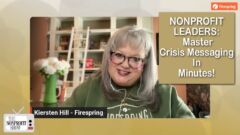
Nonprofits, take note: Crisis is not a possibility; it’s an inevitability. And when it hits, your communication strategy can either reinforce your credibility or destroy it. In this powerhouse conversation, Kiersten Hill, Director of Nonprofit Solutions at FireSpring, lays out an unfiltered, practical, and downright essential playbook for crisis communication.
Let’s be clear: saying “No comment” is the worst move you can make. As Kiersten puts it, “The last thing you ever want to say is ‘no comment.’ It automatically makes you look guilty.” Instead, she urges organizations to take control, acknowledge the situation, and craft a response that is strategic, transparent, and mission-driven.
Beyond just reacting, Kiersten emphasizes that proactive communication with board members, donors, and the public is the best defense against misinformation and panic. She champions a mindset shift: invest more in marketing and communication during a crisis, not less! If your instinct is to cut budgets and go silent, you’re setting yourself up for long-term damage.
For every nonprofit leader out there, this is a must-watch. Because let’s face it—crises don’t wait for you to be ready.
#CrisisCommunication #NonprofitLeadership #nonprofitComms Follow the ongoing conversation at #TheNonprofitShow

How do you transform a simple document into a powerful storytelling tool that inspires donor action? That’s exactly what cohosts Julia Patrick and Tony Beall tackled on this week’s Fundraisers Friday episode on How to Use Case Studies in Fundraising.
Case studies aren’t just dry reports filled with data; they are dynamic narratives that celebrate an organization’s impact. As Tony put it, “A case study is a celebration of the work and the accomplishments of your organization.” Rather than seeing them as another bureaucratic task, nonprofits should recognize them as strategic storytelling tools that capture purpose, execution, and impact.
The fast-paced conversation highlights the importance of humanizing data with powerful testimonials—from clients, volunteers, or even city officials—adding credibility and emotional depth. Julia points to this shift in nonprofit storytelling: “The sense was if you don’t have images of devastation, you won’t light a fire under anyone—but now we’re seeing hopeful, positive images of impact.”
Another key takeaway you’ll find? Who owns the case study? While some organizations leave this to research teams, Tony emphasized the role of marketing in crafting an engaging, visually compelling narrative. Plus, if nonprofits lack resources, they can partner with universities, business associations, and even SCORE (Gov’t agency) to leverage external expertise.
The duo wrapped up with a powerful call to action: case studies aren’t just about the past—they should be forward-thinking tools that drive engagement, build donor trust, and inspire action. Whether used for grant applications, board reports, or major donor conversations, these documents must prove why the organization’s work matters. Follow the ongoing conversation at #TheNonprofitShow

In the dynamic world of nonprofit fundraising, where digital tools and transactional techniques often dazzle, Sherry Quam Taylor sounds a clarion call back to the essentials—deep, transformational relationships. As we roll into 2025, Sherry delivers a message to fundraisers to ‘refocus on the fundamentals of building meaningful donor connections, rather than chasing the latest tech-driven trends’.
Throughout this compelling conversation with host Julia Patrick, Sherry dissects the misconceptions of modern fundraising, emphasizing that while technology and events have their place, they shouldn’t overshadow the power of one-on-one relationships. Too many nonprofit professionals, she warns, have become "glorified admin fundraisers," trapped by the allure of automation and transactional efficiency at the cost of real genuine engagement.
"We want 50 to 75% of your annual revenue coming from relationships," Sherry offers up . . . "Donors give their best gift because of relationships, not because of flashy campaigns."
She challenges NPO leaders to analyze their time and effort allocation, pushing for more data-driven decision-making when it comes to fundraising events. One interesting case study she describes, revealed that less than 20% of a gala’s revenue came from outside donors, prompting the NPO to take a hard look at their ROI.
Continuing, Sherry introduces a powerful paradigm shift—leveraging brand authority on platforms like LinkedIn to attract mid-to-major-level donors. "We can’t hide anymore. Our donors need to see us as the thought leaders we are," she says.
You’ll agree that Sherry’s insights can push the sector toward a more sustainable, relationship-centered fundraising model, so that nonprofits not only survive but thrive in the coming years. Follow the ongoing conversation at #TheNonprofitShow
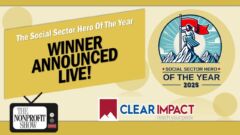
What happens when data, dedication, and passion collide? A revolution in nonprofit impact measurement! Host Julia Patrick welcomes Adam Luecking, CEO and co-founder of Clear Impact, for an unprecedented live reveal of the 'Social Sector Hero' of the Year 2025!
After months of uating 60+ nominees from 15+ countries, they announce a game-changing leader in social impact-- the well-deserved winner is FurnitureBank.org!
Dan Kershaw, the Executive Director, and his team, redefine what it means to create lasting change, ensuring that homes become more than just four walls—they become spaces of dignity and comfort.
Furniture Bank not only provides essential home furnishings but also promotes sustainability by diverting thousands of pounds of furniture from landfills each year. Their impact is immediate and tangible—donated items are often placed in homes within 72 hours, making a real difference in the lives of families, refugees, and individuals transitioning out of homelessness. As Dan puts it: "It’s about creating a home, not just housing."
Adam elaborates on the importance of Furniture Bank’s measurable impact: "Their impact was clear and compelling, and the data showed their transformative outcomes for those they serve." Dan highlights the often-overlooked issue of furniture poverty: "The need for food banks is well known, but who thinks about furniture banks? The type of poverty we address happens behind closed doors."
This recognition of Furniture Bank showcases the power of data-driven decision-making in the nonprofit sector. Adam describes how ‘Clear Impact Scorecard’ equips organizations like Furniture Bank with tools to measure success, refine strategies, and communicate their results effectively.
It’s a testament to how data-driven strategies can revolutionize nonprofit success, proving that numbers tell a powerful story—one of hope, transformation, and measurable impact. Watch, learn, and be inspired! And maybe apply for the award next year for your nonprofit? Follow the ongoing conversation at #TheNonprofitShow
